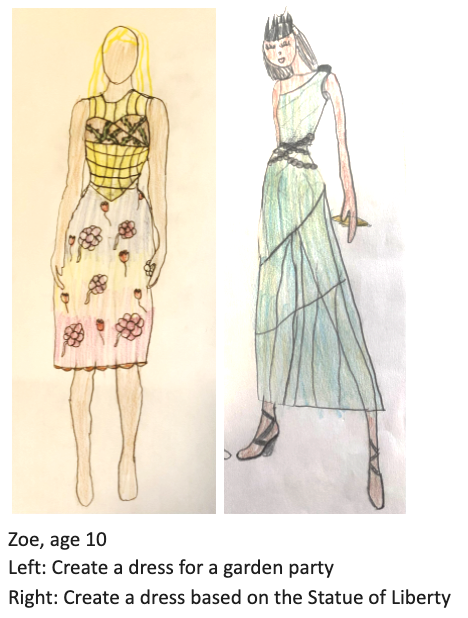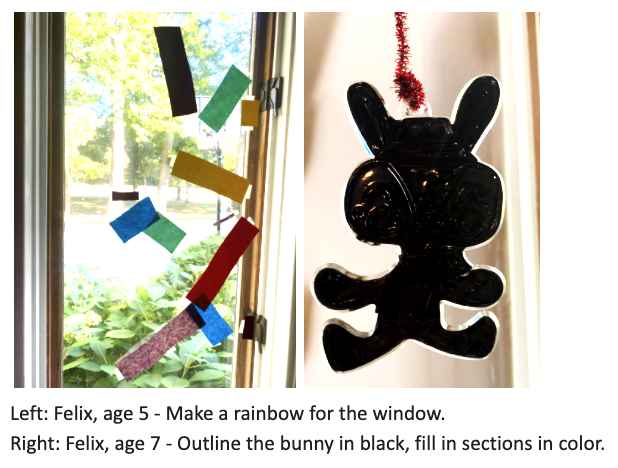Seeing Myself, Seeing the World: Reflections on Art, Relevance, and Curriculum
October 19, 2021
By Carey Swanson
Capturing a Moment in Time
My ten-year-old daughter is a reader, sensitive, and a rule follower. She’s recently fallen in love with fashion design, and she draws outfits and people with care. She plans her designs with goals in mind. She googles to search clothing and culture and mimics but innovates or embellishes on the design, adding details that she sees or learns about.

My son is an experimenter, impulsive, and a rule bender. He resists following any model, even in making a birthday card. He scribbles, cuts, glues, and finds his own way to vary from the form, even when using a step-by-step craft kit.

We’re an arts-oriented household. Their father is an artist, and they are able to put themselves into their creations all the time. In education, folks often talk about “making learning visible,” but in moments like this, I find the process of art makes my children visible. The results of their work provide a window into my children’s young lives- an actual picture, a moment in time, capturing a bit of who they are and how they see the world and express themselves.
Helping Students Understand Who They Are and Their Life’s Context:
In schools across the country, children spend upwards of six hours in class after class, in classes called ELA, math,science, social studies and art. The experiences in those classrooms, while often viewed the same in discussion and debate, in policy conversations, school boards, and PTO meetings can vary dramatically, based on the philosophy of the school, the orientation and practice of the teacher, and the quality and pedagogical beliefs of the curriculum.
As the pandemic, the resulting school closures, and the varied approaches to education across the country have laid plain existing inequities in our school systems, there has been a cry in some education circles to “reimagine schooling.” If we listen to children about what this means, we’ll see, among other things, a call to “teach them content that fills them with meaning and purpose and that leaves them with a better understanding of who they are and the context in which they will live their lives.”(1) If we listen to the experts, like Dr. Gloria Ladson-Billings, a leading scholar who introduced the term “culturally relevant pedagogy,” we hear a call to action. Ladson-Billings charges us, specifically on behalf of Black students and students marginalized by schooling, to not go back to normal and instead do a “hard re-set”(2). Ladson-Billings states, “Specifically, we must re-set around technology, curriculum, pedagogy, assessment, and parent/community engagement that will support and promote students’ culture” (3). Might educators who are truly interrogating their practice and making changes to fulfill these needs find ways to make not only learning but the children in their classrooms visible in intentional ways?
Using Art as a Platform to See Students:
How do we support and promote students’ culture? How do we ensure that students both learn and feel seen in the work that they do? Rudine Sims Bishop talks about the concept of the importance of mirrors, windows, and sliding glass doors when it comes to representation in text. This means that children have the chance to see themselves in what they read, the chance to build knowledge about other people, topics, and events in the world through texts that offer a window, and the chance to metaphorically step into other experiences through the sliding glass door (4). This perspective does not need to stop at text-based representation. When children are left to their own devices, or engaging with their friends and families, as in my examples above, they put themselves into what they create. How can we replicate this in and across homes and classrooms- wherever learning takes place?
I’d argue that art is a natural place for this to happen. This can get lost, however, when the focus becomes replicating a model or completing a task, rather than engaging in the content and the process. See how much more of the child is brought out in tasks that ask for multifaceted responses, such as this project where children learn about animal defense mechanisms and invent their own animal suited for the rainforest, or the activity in this issue where students create art using natural materials from where they live to share something about them, their community, or their region. Rich and productive art lessons can offer rigorous learning experiences, while still allowing students to be themselves, express themselves, and see themselves as “the answer” to the task they are creating.

Citations:
(1) How Students Want to Reimagine Education Next Year (Opinion) (edweek.org)
(2) August, 2020 interview with Emily Frietag and Dr. Gloria Ladson-Billings, https://instructionpartners.org/2020/08/07/dr-gloria-ladson-billings/
(3) Gloria Ladson-Billings (2021) I’m Here for the Hard Re-Set: Post Pandemic Pedagogy to Preserve Our Culture, Equity & Excellence in Education, 54:1, 68-78, DOI: 10.1080/10665684.2020.1863883
(4)Bishop, R. S. (1990). Mirrors, windows, and sliding glass doors. Perspectives: Choosing and Using Books for the Classroom, 6(3).

Carey Swanson
Board Member, Doodles Academy
Carey Swanson is a Designer at Student Achievement Partners with a focus on literacy. Projects she supports center around the work of learning to read, as well as immersive literacy experiences with texts and topics that reflect and affirm students’ identities and expand their knowledge of the world around them. Prior to working at SAP, Carey was a school leader and teacher in NYC for 15 years, and believes in the promise of learning that a reimagined approach to school has the potential to fulfill.

